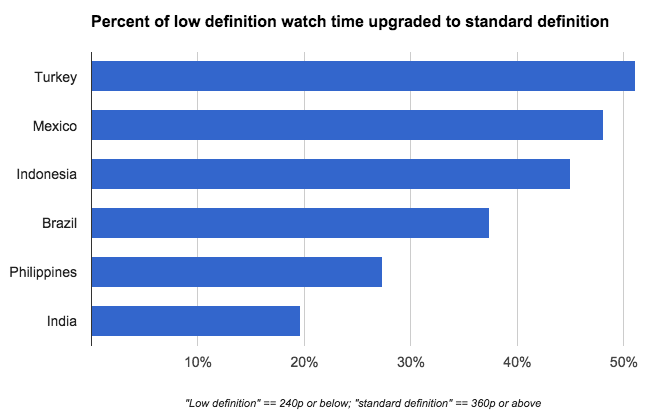VP9 Codec Already Represents Significant Portion Of YouTube Views
Google announced today that YouTube users have already watched over 25 billion hours of VP9-encoded videos during the past 12 months. VP9 is Google's own open source video codec and alternative to HEVC. It's also the successor to VP8, the codec Google received by acquiring On2 Technologies (and later made open source).
The VP8 codec didn't manage to become particularly popular in part because it arrived late, and its main competitor, the AVC/h.264 codec, was already becoming entrenched on the video market. The VP8 also wasn't competitive enough performance-wise.
Likewise, the VP9 codec arrived slightly later than HEVC, but this time Google pushed it much more aggressively to its hardware partners and via its own products and services. Although Google promised to give up on h.264 and go all-in with VP9 in Chrome back in 2011, that never happened.
Now, Google is using VP9 as its main codec for YouTube videos. According to the company, a significant portion of those 25 billion hours of videos played in the last year couldn't have been watched in HD quality without the VP9 codec.
“This new format bumps everybody one notch closer to our goal of instant, high-quality, buffer-free videos. That means that if your Internet connection used to only play up to 480p without buffering on YouTube, it can now play silky smooth 720p with VP9," said Google in a blog post.
Mobile users, or those who live in countries where data plans are expensive, can also save money or bandwidth by watching VP9-encoded videos instead of h.264-encoded ones. At the same image quality level, VP9 videos usually have a bitrate of roughly half that of h.264 videos, which gives significant bandwidth savings.
VP9 was also designed from the beginning with high resolution video content in mind. At larger video sizes, the VP9 codec becomes even more efficient compared to h.264. Therefore, thanks to VP9, YouTube is serving uninterrupted 4K streaming to a growing audience as even lower-speed connections can now play 4K videos. In the past year, the number of 4K videos being uploaded to YouTube have tripled.
Get Tom's Hardware's best news and in-depth reviews, straight to your inbox.
While Google and the MPEG-LA (HEVC's creator) are both currently pushing their own video codecs, Xiph, Mozilla, and the IETF are working on the next-generation NETVC (former Daala) codec. NETVC is supposed to go beyond the performance that the VP9 and HEVC codecs have today (roughly half the bandwidth of h.264), while at the same time not being patent-encumbered.
Follow us @tomshardware, on Facebook and on Google+.
Lucian Armasu is a Contributing Writer for Tom's Hardware US. He covers software news and the issues surrounding privacy and security.
-
Kewlx25 My only wish is that 1080p@60fps didn't result in choppier playback than non-60fps. I have a 3.5ghz Haswell quad with no HT. It shouldn't be choppy. I had to disable hardware accelerated playback because is was pretty much broken, getting something like 3fps on my AMD6950. A normal 1080p stream plays back just fine.Reply -
alidan ReplyMy only wish is that 1080p@60fps didn't result in choppier playback than non-60fps. I have a 3.5ghz Haswell quad with no HT. It shouldn't be choppy. I had to disable hardware accelerated playback because is was pretty much broken, getting something like 3fps on my AMD6950. A normal 1080p stream plays back just fine.
phenom II 955 black
8gb ddr3 800mhz (usually less than 500mb useable)
amd r9 280X OC to a ghz edition spec
60fps plays just fine for me. -
Hax0r778 Why is this article comparing VP9 to H264. It feels like a promotion article. VP8 was the competitor to H264. VP9 should be compared with H265. That's an article I'd be interested in.Reply -
ravewulf I'm still personally using x264 (via MeGUI) for all my encodes. I'm more familiar with the parameters and characteristics of it and it will continue to have the broadest support for quite some time before the next codec takes over.Reply
I have high hopes for Daala as they are creating it focusing on keeping detail and textures from the start vs current codecs that smooth and block everything then rely on post processing to make it presentable. -
azathoth This device looks pretty handy for a mobile HTPC. There has been many times I have been at a family member/friends house and none of their devices are capable of USB Media playback.Reply
Looks like it is also capable of light casual gaming as well, according to some Atom Z3735F benchmarks it can run slightly older games at lowest details. Pretty decent capability for what the device is. -
left justify ReplyMy only wish is that 1080p@60fps didn't result in choppier playback than non-60fps. I have a 3.5ghz Haswell quad with no HT. It shouldn't be choppy. I had to disable hardware accelerated playback because is was pretty much broken, getting something like 3fps on my AMD6950. A normal 1080p stream plays back just fine.
My only wish is that 1080p@60fps didn't result in choppier playback than non-60fps. I have a 3.5ghz Haswell quad with no HT. It shouldn't be choppy. I had to disable hardware accelerated playback because is was pretty much broken, getting something like 3fps on my AMD6950. A normal 1080p stream plays back just fine.
My only wish is that 1080p@60fps didn't result in choppier playback than non-60fps. I have a 3.5ghz Haswell quad with no HT. It shouldn't be choppy. I had to disable hardware accelerated playback because is was pretty much broken, getting something like 3fps on my AMD6950. A normal 1080p stream plays back just fine.
My only wish is that 1080p@60fps didn't result in choppier playback than non-60fps. I have a 3.5ghz Haswell quad with no HT. It shouldn't be choppy. I had to disable hardware accelerated playback because is was pretty much broken, getting something like 3fps on my AMD6950. A normal 1080p stream plays back just fine.
My only wish is that 1080p@60fps didn't result in choppier playback than non-60fps. I have a 3.5ghz Haswell quad with no HT. It shouldn't be choppy. I had to disable hardware accelerated playback because is was pretty much broken, getting something like 3fps on my AMD6950. A normal 1080p stream plays back just fine.
My only wish is that 1080p@60fps didn't result in choppier playback than non-60fps. I have a 3.5ghz Haswell quad with no HT. It shouldn't be choppy. I had to disable hardware accelerated playback because is was pretty much broken, getting something like 3fps on my AMD6950. A normal 1080p stream plays back just fine.
My only wish is that 1080p@60fps didn't result in choppier playback than non-60fps. I have a 3.5ghz Haswell quad with no HT. It shouldn't be choppy. I had to disable hardware accelerated playback because is was pretty much broken, getting something like 3fps on my AMD6950. A normal 1080p stream plays back just fine.
My only wish is that 1080p@60fps didn't result in choppier playback than non-60fps. I have a 3.5ghz Haswell quad with no HT. It shouldn't be choppy. I had to disable hardware accelerated playback because is was pretty much broken, getting something like 3fps on my AMD6950. A normal 1080p stream plays back just fine.
I'm having the same issues and also using a 6950. There should be no reason I cannot play 1080p60 YouTube videos whilst gaming at and above that framerate is just fine. -
jase240 ReplyMy only wish is that 1080p@60fps didn't result in choppier playback than non-60fps. I have a 3.5ghz Haswell quad with no HT. It shouldn't be choppy. I had to disable hardware accelerated playback because is was pretty much broken, getting something like 3fps on my AMD6950. A normal 1080p stream plays back just fine.
Intel integrated graphics runs 60 fps just fine with no choppiness, Nvidia cards also work well. Perhaps your drivers are not up to date or something else is wrong with your setup. -
Kewlx25 I have the newest stable drivers and I have a Windows 8.1 Pro install that is only a few months old, no registry tweaks of any kind, no special OC software, no graphics tweaking software, etc. I no longer "tweak" my system, I just use stock settings.Reply -
stevenrix VP9 or H265. I have not seen many devices that are able to encode on H265, we are still stuck in H264, to one exception with the Samsung NX1 I believe. I personally fell in love with the XAVC codec for my youtube videos (which is still a modified version of H264 with a different bitrate). So yes if youtube is VP9 compatible now it might became a general format adopted by the consumers, unlike the H265 format.Reply

